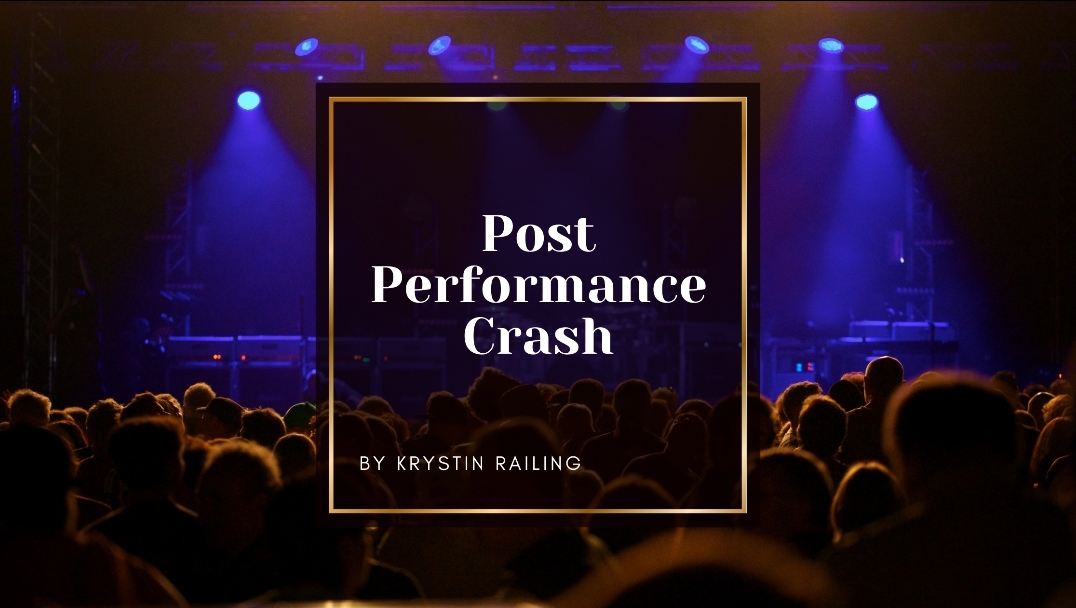Your cart is currently empty!
Post Performance Crash

Performing can be an exhilarating experience, filled with adrenaline, focus, and emotional highs. However, once the curtain falls and the applause fades, many performers experience a phenomenon known as post-performance crash. This period is marked by a sudden dip in mood and energy, where the intense highs of performing give way to feelings of fatigue, sadness, and lack of motivation. Known variously as post-performance depression or post-adrenaline crash, this state reflects the body’s and mind’s response to the abrupt drop in adrenaline and dopamine. Understanding this phenomenon is crucial for performers to manage their well-being and continue thriving in their art.
What is a Post Performance Crash?
Post-performance depression, also known as post-event letdown or post-adrenaline crash, refers to a period of emotional and physical low that can occur after the conclusion of a significant, high-energy event or performance. This phenomenon is characterized by feelings of sadness, fatigue, and a lack of motivation that contrast sharply with the high levels of excitement, adrenaline, and focus experienced during the event.
Characteristics of Post-Performance Depression:
- Emotional Low: Feelings of sadness, emptiness, or disappointment, even if the performance was successful.
- Physical Fatigue: A sense of extreme tiredness and lack of energy.
- Lack of Motivation: Difficulty feeling motivated to engage in daily activities or start new projects.
- Adrenaline Withdrawal: A drop in adrenaline levels that can lead to a feeling of depletion or burnout.
- Sense of Loss: Missing the sense of purpose, structure, or camaraderie associated with the preparation and execution of the performance.
Causes:
- Adrenaline and Dopamine Drop: During a performance, high levels of adrenaline and dopamine are produced, creating a heightened state of arousal and pleasure. When these levels drop after the event, it can lead to feelings of depression.
- Physical Exhaustion: The physical demands of performing can lead to exhaustion, contributing to feelings of low mood.
- Mental and Emotional Investment: The intense focus and emotional investment required for a performance can leave individuals feeling drained once it’s over.
- Sudden Lack of Structure: After the structured and goal-oriented period of preparing and performing, the sudden lack of structure can contribute to a feeling of emptiness or aimlessness.
Post Performance Crash Vs. Burnout:
Post-performance crash and burnout are both conditions that affect individuals after periods of intense activity or stress, but they differ in their causes, duration, and overall impact on an individual’s well-being.
Post-Performance Crash:
- Cause: Occurs after a specific event or period of high-energy performance, such as a show, competition, or project.
- Duration: Typically short-term, lasting a few hours to several days.
- Symptoms: Characterized by a sudden drop in mood, fatigue, lack of motivation, and feelings of emptiness or sadness. This is often due to the abrupt decrease in adrenaline and dopamine levels after the event.
- Nature: It is often a temporary state of low mood and energy that resolves with rest and self-care.
- Impact: Mainly affects emotional and physical state in the short term but can be managed with appropriate self-care strategies.
Burnout:
- Cause: Results from prolonged, chronic stress and overwork, often due to ongoing high demands in a professional or personal setting without adequate rest or support.
- Duration: Long-term, potentially lasting weeks, months, or even longer if not addressed.
- Symptoms: Includes chronic exhaustion, detachment, feelings of cynicism or negativity, decreased performance, and a sense of helplessness or overwhelm. Physical symptoms may include headaches, gastrointestinal issues, and sleep disturbances.
- Nature: It is a more pervasive and persistent condition that affects one’s overall well-being and can significantly impact daily functioning and health.
- Impact: Affects multiple areas of life, including work, personal relationships, and physical health. Recovery often requires substantial changes in lifestyle, workload, and sometimes professional intervention.
While post-performance crash is a temporary state of low energy and mood following a high-energy event, burnout is a long-term, chronic condition resulting from ongoing stress and overwork. Addressing a post-performance crash typically involves short-term self-care, whereas managing burnout often requires more significant and long-term changes to one’s lifestyle and work habits.
Management Strategies:
- Self-Care: Engaging in self-care activities such as rest, proper nutrition, and relaxation techniques.
- Physical Activity: Gentle exercise to help boost mood and energy levels.
- Connection: Talking to friends, family, or colleagues about your feelings.
- Mindfulness: Practicing mindfulness or meditation to stay grounded.
- Routine: Maintaining a consistent routine to provide a sense of stability.
Understanding and acknowledging post-performance depression is the first step in managing it effectively and ensuring long-term emotional and physical well-being.
Recognizing and managing post-performance crash is essential for maintaining a performer’s overall well-being. By implementing self-care strategies, staying connected with supportive networks, and establishing routines, performers can navigate the emotional and physical lows that follow their high-energy events. Embracing these practices not only helps mitigate the impact of post-performance depression but also ensures a healthier, more sustainable approach to their craft. Understanding and addressing this phenomenon allows performers to continue delivering their best while caring for their mental and physical health.